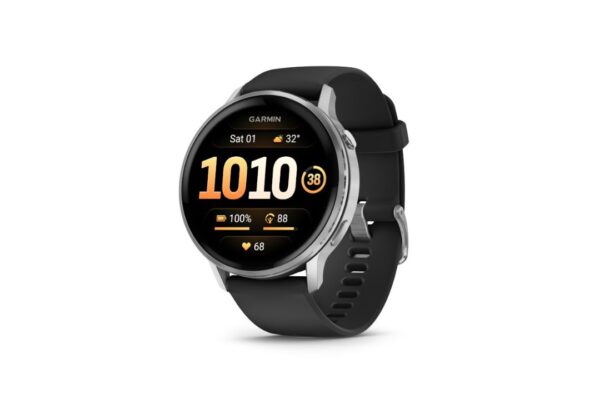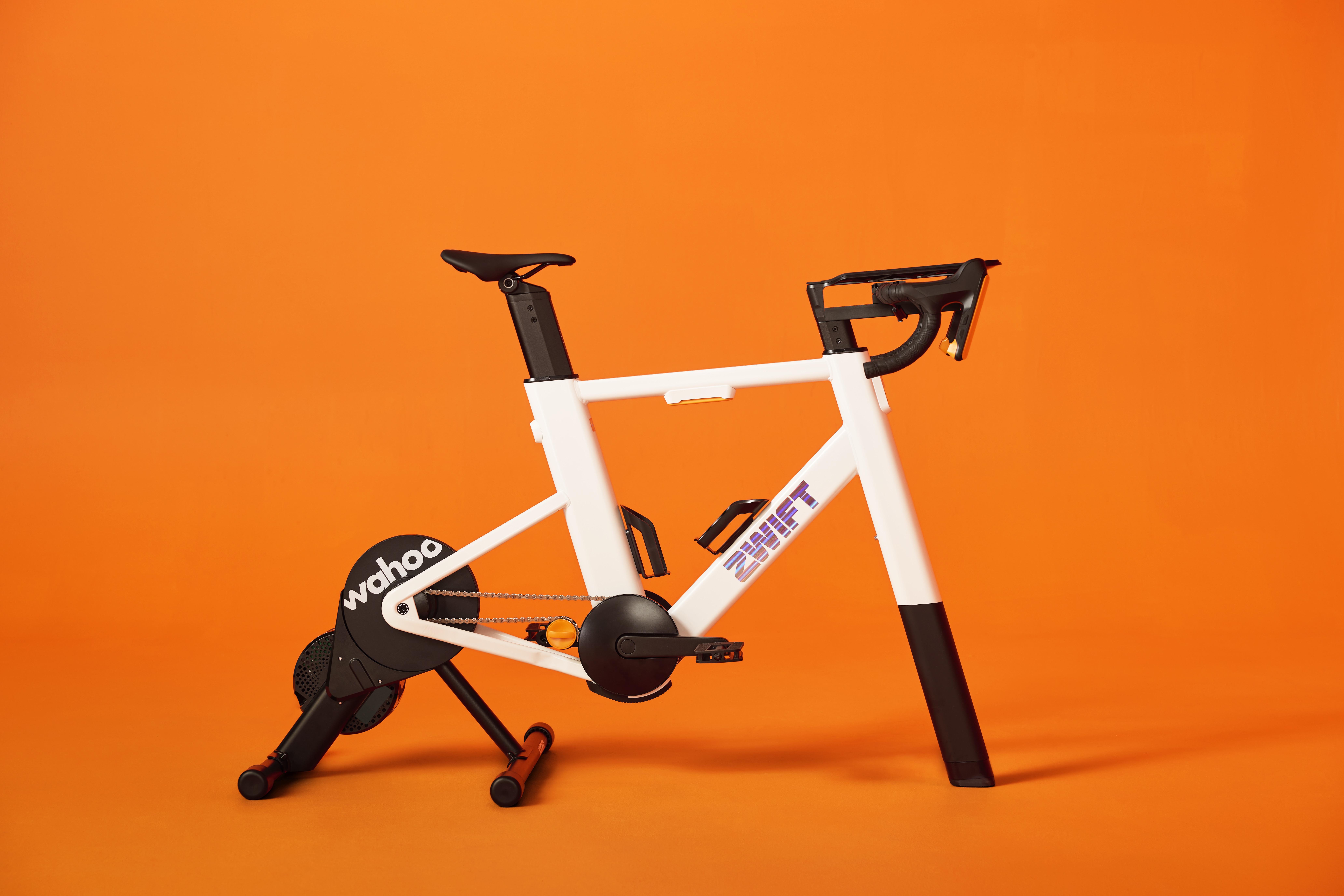Garmin have launched their latest power pedals, The Rally 110/210. 110 denotes single sided pedals whilst the 210 is Garmin’s dual-sided offering.
I have been using the Rally RK210, which is the Look Keo version and this is the third pair of Garmin pedals I have owned, having previously used their Vector 2 and Vector 3. The Rally RK210 is a significant improvement as to what has come before.
Pedal types
The Rally 110/210 is available in different cleat types and have slightly different naming conventions to denote the difference pedal type; there is the Look Keo (RK210), Shimano SPD SL (RS210) and Shimano SPD (XC210). As the power spindle is interchangeable, Garmin is offering a bundle that includes two pedal types, one for road cycling, the other for mountain biking.
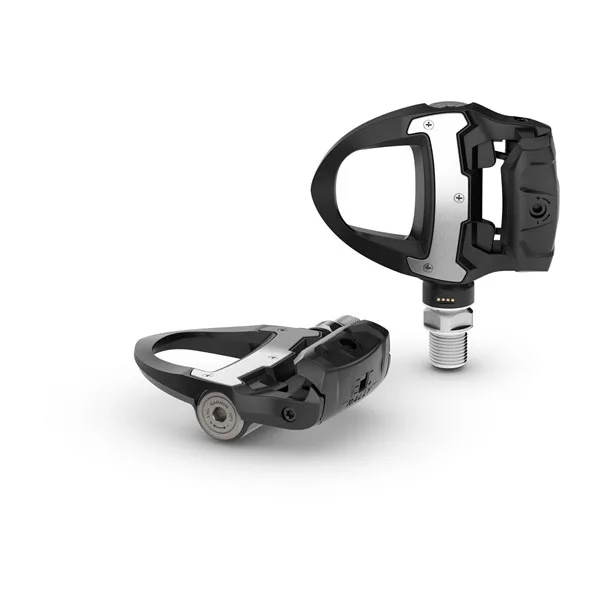

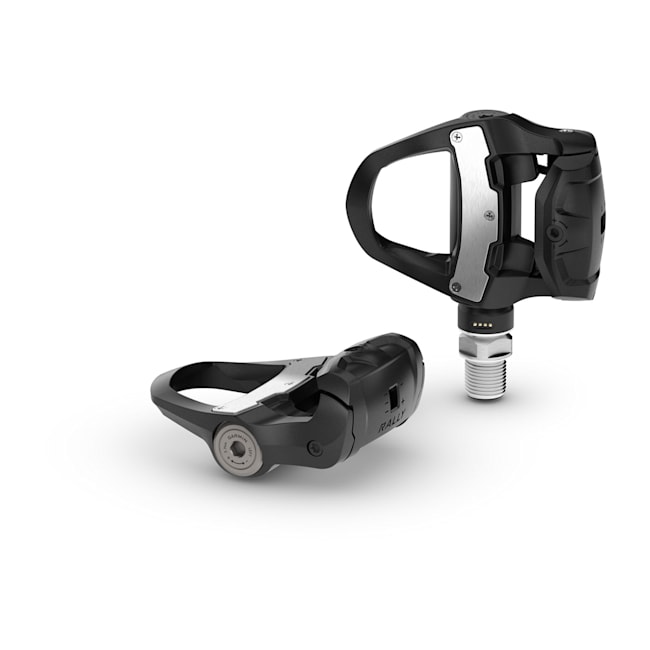
Setting up
Installation of the pedals is standard. Once loosely fitted in the crack arm, rotate them anti-clockwise with a 15mm pedal wrench then tighten to 35N-m using a torque wrench.
The fundamental step in the process is that you need to connect the pedals to your Garmin Connect app before you can pair with your Garmin Edge, for example. Overall, setting up is straightforward and works without having to spend time dissecting every page of the manual, which I’ll now briefly outline.
Before you can pair the pedals using Bluetooth with a smartwatch or cycling computer (e.g. Garmin Edge), you must pair them by first using the Garmin Connect app. There is a large piece of paper with a QR code in the box, when you open it. Simply scan the code with your phone and the Garmin Connect app will open if you have it already installed.
The pedals support secure pairing via Bluetooth. For devices that don’t support this, the pedals will need to be configured to allow open connections, meaning the device can been seen by all and this can be done from the Garmin Connect app.
Once you have completed these steps, you will be able to pair the pedals with your device such as a Garmin Edge. You will then need to input your crank length to configure and that’s it.
Redesign
From the outset, it would appear that Garmin have deliberately looked at how to make the overall product more streamlined. As mentioned, the physical process of installing and setting up the pedals is simple, and both pedal types have been redesigned to make them physically subtler, with the major overhaul being the battery.
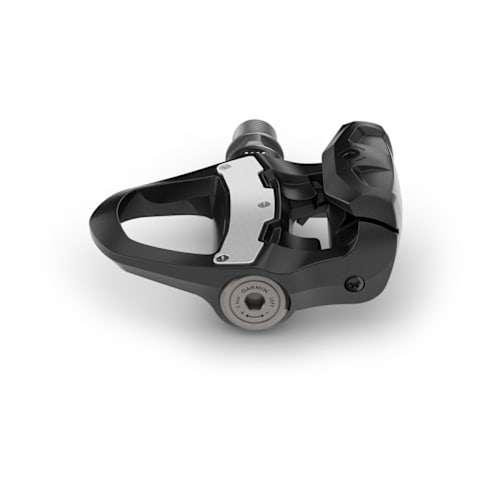
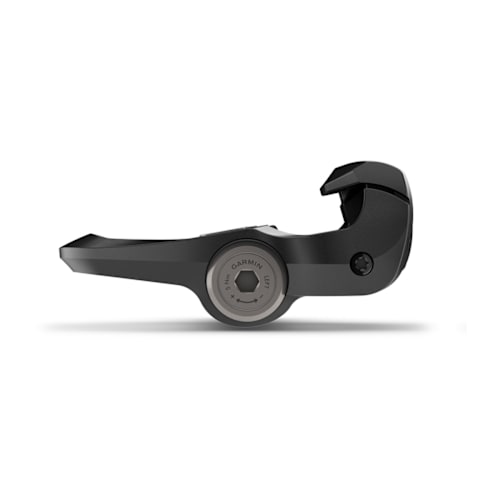
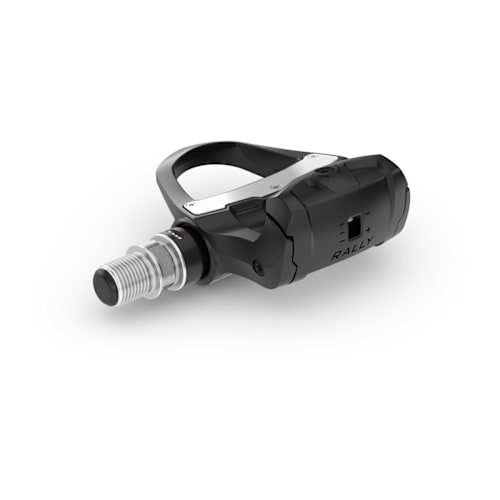
The Garmin Vector 3 had a battery compartment that often posed a challenge. It was simple enough to open, but replacing the batteries without removing the pedals was a challenge and also securing the battery compartment properly after changing them. Sometimes the replacement batteries needed a dab of mineral oil to ensure the connections worked.
However, these issues have been eliminated with the 110/210 as the new pedals have internal rechargeable batteries and a full charge can last up to 90 hours. Garmin note that with only 15 minutes of charging, you will have 12 hours of use, which is impressive. If you suddenly go to ride your bike and realise that the pedal batteries don’t have the required charge, you won’t have much time to wait before you can be riding.
The Garmin Rally110/210 pedals feature rechargeable batteries and are charged using a specific charging clip and USB-C cable included in the box.
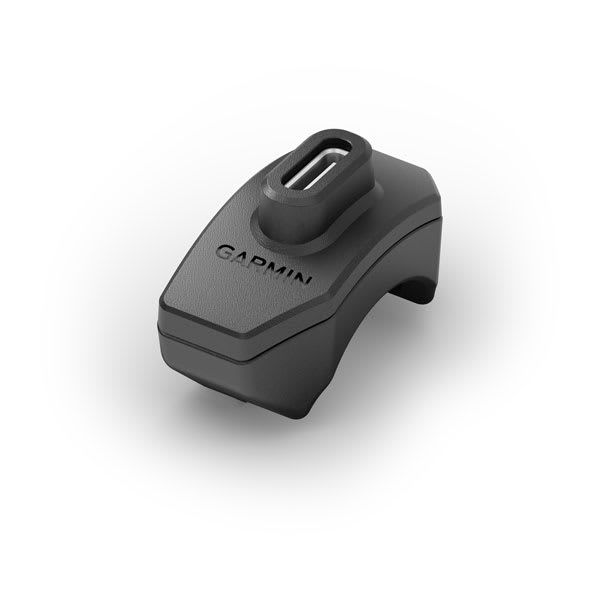
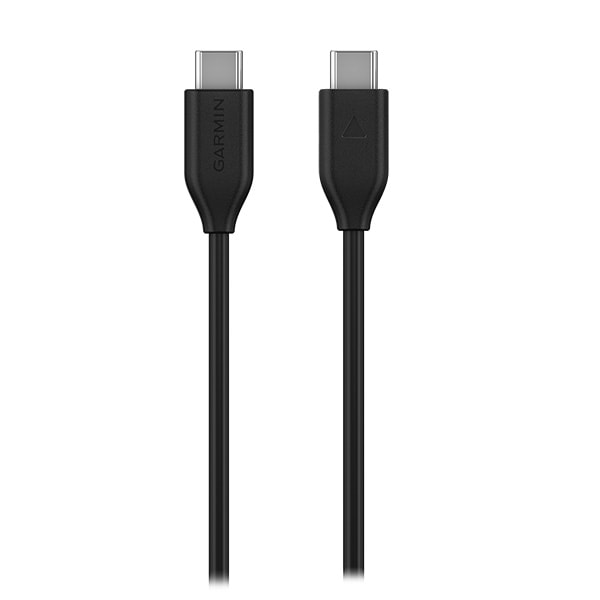
Charging Instructions
1. Connect the Charger: Connect the provided USB-C cable to the charging adapter.
2. Attach to Pedal: Connect the charging adapter to the pedal spindle, ensuring the pins on the adapter are aligned with the charging contacts on the pedal spindle.
3. Connect to Power: Plug the other end of the USB-C cable into a power supply, such as a compatible USB-C port or an AC adapter rated for 2 to 2.5 Watts of power. The AC adapter is typically not included.
4. Monitor LED: The LED light on the threaded end of the spindle will flash to indicate that charging is in progress. A short flash every 0.5 seconds indicates the charging is complete.
5. Charge Both Pedals (if applicable): If you have a dual-sensing system (RK210), repeat the process for the other pedal. For the single-sensing RK110, only the left pedal has the power sensor.

The RK110 pedals have a “travel mode” that can be activated to conserve battery life during transport.
Ensure the charging port’s rubber cover is properly closed after charging to protect the electronics from water and debris.
Price
Historically, it was mainly only professional cyclists that used power meters, in part due to their high costs. However, the increase in indoor cycling has meant that cyclists’ familiarity with watts and their meaning has increased, and people want this data when cycling outdoors. This knowledge comes with a premium price. Prices start at £929.99 / US $1,199.99 / €1,099.99 for dual-sided road pedals and rise to £999.99 / $1,299.99 / €1,199.99 for dual-sided off-road pedals.
The singled-sided pedals are priced at £594.99 / US$749.99.
Garmin offer an upgrade kit, so if you had previously bought the single-sided kit, you can upgrade to dual-sided later on.
Key Features
Interchangeable pedals:
One key feature of these pedals is that the spindle can be removed, and different pedal bodies can be used. If you ride both a road and mountain bike, this is where this feature is particularly useful. In addition, it is nice to know that if you ever damage your pedal, you can simply replace the main body.

To remove the pedal from the spindle, you will need to remove the pedal from the crank arm, then unscrew the end cap of the pedal using a 5mm Allen key / hex wrench, whilst holding the other side with the 15mm pedal wrench. You may need some help with this as it’s not easy with only one pair of hands.
Wear plates:
The Rally RK210 pedals have wear plates that are replaceable. If you are installing new pedals, I would suggest installing new cleats. My worn cleats scuffed these new plates, which was not ideal.
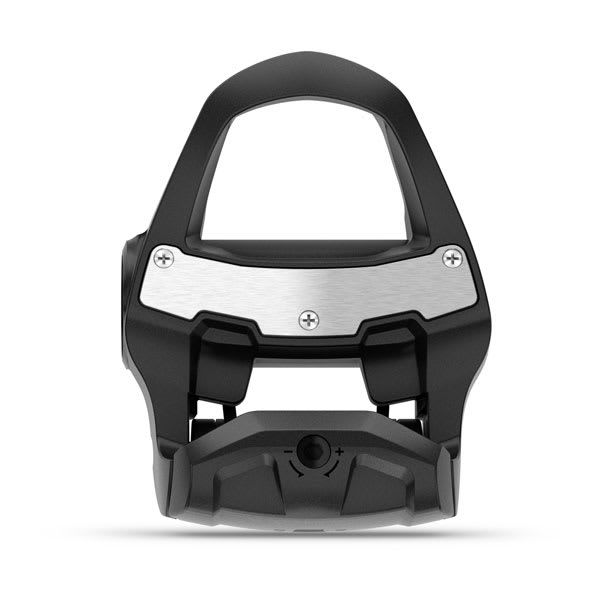
Cycling Dynamics:
With a dual-sensing, pedal-based power meter system such as the Rally™ 210 pedals, you can access advanced training data known as cycling dynamics. Cycling dynamics is a type of advanced training data that can be viewed on your Garmin Edge or on the Garmin Connect app after your ride and it enables you to gain a thorough understanding of how you apply power to the pedals and how your performance varies depending on body position, bike configuration, ride duration, and other factors by using cycling dynamics. Other information that is available according to Garmin is as follows:
Right/Left Balance – Tracks the percentage of total power applied to each pedal.
Power Phase – Tracks the start and end of the power phase (the part of your pedal stroke in which you generate positive power).
Seated/Standing Position – Tracks your riding position throughout the ride.
Platform Center Offset – Tracks how force is distributed across the pedal platform during the pedal stroke, measured in millimetres from the center line of the pedal platform.
Key Technical specs
| Pedal name | Rally™ RK210 | Rally™ RK210 | Rally™ XC210 |
| Weight | 312 g (11.0 oz) | 312 g (11.0 oz) | 436 g (15.4 oz) |
| Stack height | 12.2 mm (0.48″) | 12.2 mm (0.48″) | 11.5 mm (0.45″) |
| Maximum rider weight | 231.5 lbs (105 kg) | 231.5 lbs (105 kg) | 231.5 lbs (105 kg) |
| Cleat type | Look Keo | SHIMANO SPD-SL | SHIMANO SPD |
| Pedal body materials | Carbon material based design | Carbon material based design | All metal pedal body |
| Battery Type | rechargeable lithium-ion | rechargeable lithium-ion | rechargeable lithium-ion |
| Communication | ANT+®, Bluetooth® and USB (USB-C compliant) | ANT+®, Bluetooth® and USB (USB-C compliant) | ANT+®, Bluetooth® and USB (USB-C compliant) |
Performance
I wanted to see how the Rally RK210 pedal results compared to the data generated by the Elite Justo smart trainer, so consequently, I did a series of rides on Zwift, which included some sprints. As you can see from this one ride, the Rally RK210 pedals responded accordingly with data closely matching that recorded by the smart trainer.
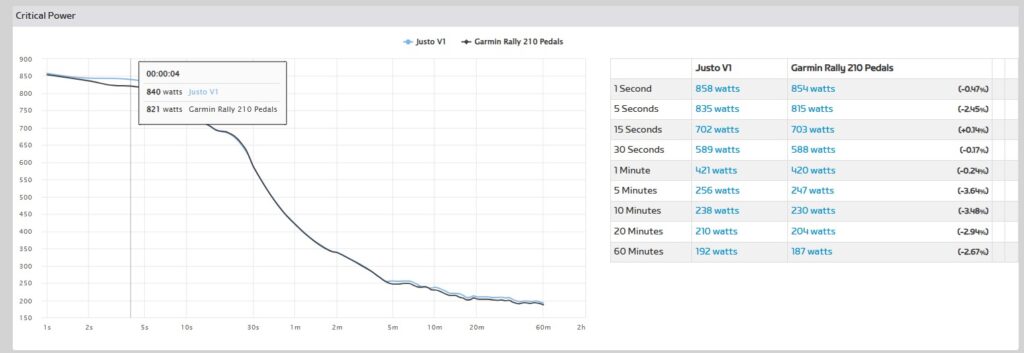
Garmin has noted that the pedals are within 1% accuracy. When compared to the Elite Justo smart trainer, the difference in Normalised Power was only 1.11% with the Elite Justo reading slightly higher, so in terms of accuracy, it’s as close as Garmin state.

Summarising
Overall, these pedals are a significant step up from what I have been used to using, the main point being the rechargeable batteries. I no longer have the inconvenience of firstly having to source some replacement batteries and, secondly, the inconvenience of having to change them. I also like the fact that the pedal bodies are interchangeable with mountain bike pedals. In terms of the physical look, the Rally RK210 are certainly more streamlined than previous Garmin Vector 2 and 3 pedals.
In terms of data that is available, there is more than enough for me to analyse. The key point is that they seamlessly worked with my Garmin Edge 1030.
To summarise, the Garmin Rally RK210 pedals represent a significant advancement in their previous offerings. With impressive data analytics capabilities, seamless setup, rechargeable batteries, and interchangeable pedal bodies make these pedals are an investment aimed at cyclists seeking to elevate their performance.

